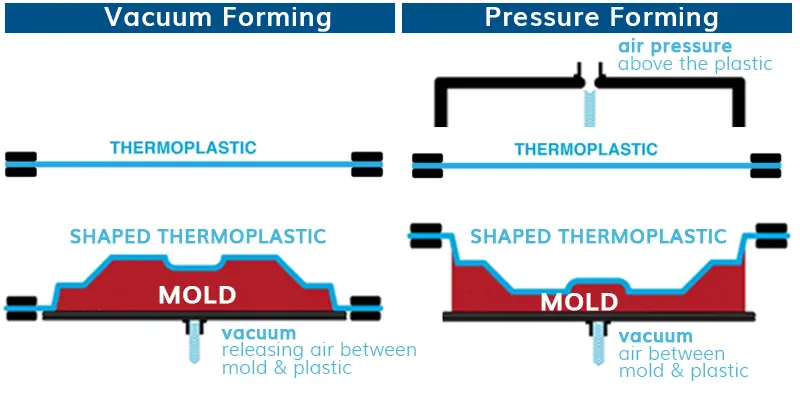
Thermoforming Processes
What you need to know
Thermoforming is a universal term for different thermoforming processes, such as vacuum forming and pressure forming. All pressure formers are vacuum form, but not all vacuum formers can pressure form. Have we confused you yet?
Vacuum forming uses only vacuum to pull a thermoplastic sheet against a mold, whereas pressure forming leverages both vacuum and positive pressure to form the material against the mold. The differences among these processes are detailed below.
Thermoforming: shaping a thermoplastic sheet by the use of heat and pressure.
Vacuum Forming: a thermoforming process where a thermoplastic sheet is heated to a bendable state, using controlled temperature, then pulled against a three-dimensional mold, by vacuuming out air between the plastic sheet and the mold.
Advantages: ideal for larger parts and production runs of less than or up to 10,000 units. What are the specific advantages? Speed, total cost, simpler tool? What are the limitations (complex geometries?)
Pressure Forming: a thermoforming process where a thermoplastic sheet is heated to a bendable state, using controlled temperature, then pressed against a three-dimensional mold, by simultaneously vacuuming out air between the plastic sheet and the mold and applying air pressure above the plastic.
Advantages: perfect for custom enclosures, able to obtain higher detailed and textured finishes
You don’t need to be an expert, we are.
Still not sure what process is best suited for your packaging project? Contact one of our packaging experts today to discuss your next project!
Contact Our Team of Experts to Get Started Today!
Learn more about our two million square feet of production and distribution space, explore our capabilities and services, or connect with our experienced project teams to get started today!




